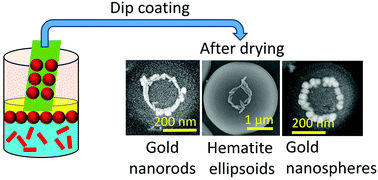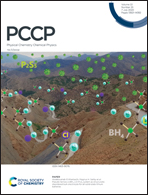Self assembly of nanorods on microspheres at fluid–fluid interfaces†
Abstract
The potential applications of metal nanoparticles require their assembly/deposition on different solid matrices. In this work, an experimental method is demonstrated to assemble gold nanorods (AuNRs) as a ring-like structure on polystyrene (PS) microspheres at the fluid–fluid interface via dip-coating followed by solvent evaporation. The effects of AuNR concentration, size and surface charge of PS particles and size of AuNRs on the formation of AuNR ring-like structures on templated PS particles are investigated. A mechanism based on the evaporative drying of a liquid capillary bridge hinged between two PS microspheres is proposed for the formation of the ring-like structure on the PS microspheres. As the liquid evaporates from the pinning line on the PS microsphere surface, the ring-like structure is formed by the convective deposition of AuNRs. The decane–water interfacial tension dictates the position of the pinning line and thus controls the position/diameter of the ring on the PS microspheres. The ring diameter is found to be strongly affected by the template particle diameter. The generality of the experimental scheme is demonstrated by making a ring-like deposit of hematite ellipsoids on PS particles and their position is varied by changing the oil–water interfacial tension via the addition of a surfactant. The work demonstrates a simple, scalable and interface-based method of depositing both spherical and non-spherical nanoparticles on microspheres, which allows the manipulation of nanoparticles as functional components in fabricating devices.



 Please wait while we load your content...
Please wait while we load your content...